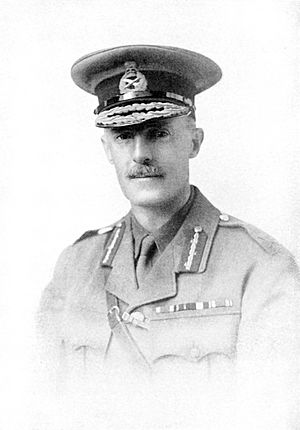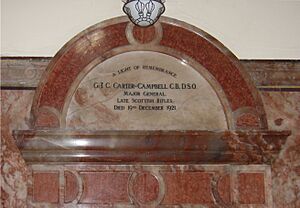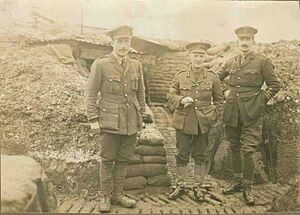George Carter-Campbell facts for kids
Quick facts for kids
George Carter-Campbell
|
|
|---|---|
 |
|
| Born | 2 April 1869 Kensington, London |
| Died | 19 December 1921 (aged 52) London, England |
| Allegiance | United Kingdom |
| Service/ |
British Army |
| Years of service | 1889–1921 |
| Rank | Major General (1915) |
| Unit | Cameronians (Scottish Rifles) |
| Commands held | 2nd Battalion, Cameronians (Scottish Rifles) 94th Brigade 51st (Highland) Division |
| Battles/wars | Second Boer War World War I |
| Awards | Order of the Bath Distinguished Service Order Order of St. Stanislaus Légion d'honneur Croix du Commandeur Mentioned in dispatches |
| Relations | Thomas Carter (Rt. Hon., M.P., Secretary of State and Master of the Rolls), General George Campbell of Inverneill, C.B., K.A Admiral John Carter, Colonel Alexander Campbell of Possil, Major General Sir Archibald Campbell, General Sir James Campbell of Inverneill, Colonel Duncan Carter-Campbell of Possil, Willoughby Harcourt Carter |
Major General George Tupper Campbell Carter-Campbell (born April 2, 1869 – died December 19, 1921) was an important officer in the British Army. He served in two major conflicts: the Second Boer War and the First World War.
Contents
Early Life and Family
George Carter-Campbell was born in Kensington, London. He was part of the Carter-Campbell of Possil family. His father was Thomas Tupper Carter-Campbell of Possil. His mother was Emily Georgina Campbell.
Military Career
George Carter-Campbell began his army training at the Royal Military College, Sandhurst. He became a second lieutenant in the Cameronians (Scottish Rifles) on October 23, 1889. He quickly moved up the ranks. He became a lieutenant in 1892 and a captain in 1897.
Serving in the Second Boer War
Carter-Campbell fought in the Second Boer War from 1899 to 1902. He was an adjutant for the 2nd Battalion. This unit helped in the Ladysmith Relief Force. He was present at several battles, including Colenso and Spion Kop.
His unit served in Natal and then in Transvaal. For his brave service, he was promoted to brevet major. He was also mentioned in official reports twice. After the war ended, he returned to the United Kingdom in August 1902.
World War I Service
When World War I started, Carter-Campbell went to France with the 8th Division. He was second-in-command of his battalion. He was injured during the Battle of Neuve Chapelle in March 1915. For his actions, he received the Distinguished Service Order and the Order of St. Stanislaus.
He then took command of his battalion. Later, he was promoted to brigadier general in September 1915. He led the 94th Infantry Brigade. During this time, he also became a lieutenant colonel and then a Brevet-Colonel.
In March 1918, he took command of the 51st (Highland) Division. He led this division until he moved to the Rhine to command another brigade. While leading the 51st Division, he received the C.B. award and the French Legion of Honour.

After the War
George Carter-Campbell was wounded during the First World War. After he recovered, he became the General Officer Commanding (GOC) for Northern Ireland in 1920.
Sadly, he died in 1921 in London. His health had been greatly affected by his time serving in the war.
Family Life
George Carter-Campbell married Frances Elizabeth Ward. They had two children together. Their daughter was Dorothy Catherine Carter-Campbell, born in 1909. Their son was Duncan Maclachlan Carter-Campbell, born in 1911.
See also
- List of Légion d'honneur recipients by name
- Covenanter
- Cameronian


